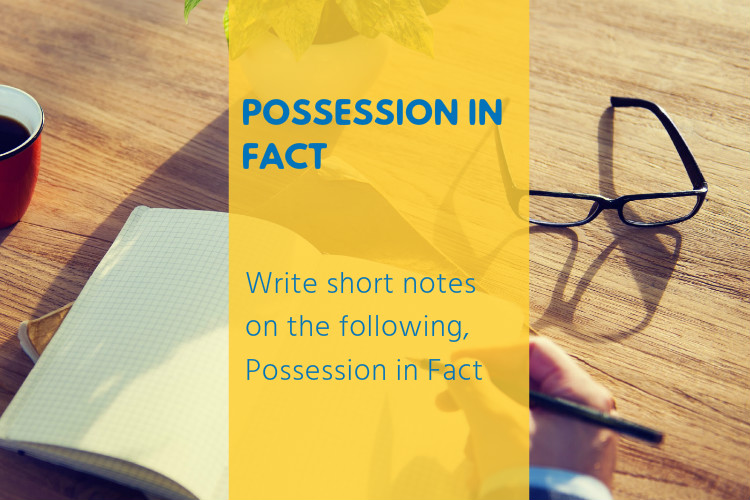Write short notes on the following :
(a) Possession in Fact
(b) Possession in Law
(c) Ihring’s Theory of Possession
(d) Corporeal and Incorporeal Possession
(e) Mediate and Immediate Possession
(f) Concurrent Possession or Duplicate Possession
(g) Constructive Possession
(h) Adverse Possession
Ans. (a) Possession in Fact—The relation between a person and a thing which he possesses is called possession infact or defacto possession. It indicates physical control of a person over a thing. For instance, if a person has caged a parrot, he would be deemed to have possession of it so long as the parrot is in the cage but as soon as the parrot escapes from the cage or set free, he would lose possession over it. Certain points regarding ossession infact must be carefully noted. They are:
(I) There are certain things over which a person cannot have physical control e.g. sun, moon, stars etc.
(2) The physical control over the object need not be continuous. For instance, I possess my coat when I am wearing it, I still have posses-sion of it when I take it off and hang it on a peg when I go to sleep. The basic idea is that I should be in a position to resume control over it in normal course whenever I so desire. In other words, physical control may continue even if a person relinquishes actual control temporarily.
(3) In order to constitute possession infact, merely having physical control of a thing is not enough but it must be accompanied by capacity to exclude others from the possession of it. However, some jurists do not consider this element necessary for possession.
(4) In order to determine the question of acquisition, abandonment or termination of possession, the distinctive feature is the desire of the person whether he desires to retain possession or not.
Ans. (b) Possession in Law:—Possession in Law is also termed as de jure possession. It has already been stated that the law protects pos-session for two obvious reasons, namely:
(i) by conferring certain legal rights on the possessor;
(ii) by penalising the persons who interfere with the possession of aperson or by making him pay damages to the possessor. Whenever a person brings a suit for possession the first thing that the Court ascertains is whether the plaintiff was formerly in real possession of the thing in dispute. It is true that in most of the cases actual or factual possession testifies legal possession yet there are many situations when a person does not have possession in law although he is in actual possession of the object.
In the legal sense, possession is used as a relative term. The law is generally not concerned with the question as to who has the best title, but it is concerned as to which of the parties before it has a better title.
Ans. (c) Ihring’s Theory of Possession:—Ihring’s Theory of pos-session appears to be more practical and realistic. Taking an objective view he adopted a sociological approach explaining the concept of possession in his theory. He justificed protection of possession under Roman law and said, ‘whenever a person looked like an owner in relation to a thing, he had possession of it, unless possession was denied to him by rules of law based on practical convenience.” The element of animus was, therefore, merely an intelligent consciousness of the fact of possession. Thus Ihring was more practical in approach and did not not insist on presence of animus as an element of possession. He considers animus only as a supplemental element for possession.
For Ihring, possession is ownership on the defensive. A person who is exercising ownership infact (that is the possessor) must be pro-tected and be free from the necessity of proving title against a person who is in unlawful possession.
Although Ihring’s theory of possession is more acceptable than that of Savigny’s theory but it also suffers from certain shortcomings. Firstly, Ihring analysed the concept of possession purely in the back-ground of Roman possessory interdicts and, therefore, it fails to explain the cases where law refused ‘possessory rights’ to persons who were in effective physical control of the thing possessed.
Ans. (d) Corporeal and Incorporeal Possession:—Corporeal possession is the possession of material things like land, house, buildings and movables like books, chattels etc. In the case of corporeal posses-sion, the corpus consists firstly in confirming exclusion of other’s inter-ference and secondly in the enjoyment of the thing at will without external interference. Actual use of thing is, however, not necessary. Thus a person may keep his watch locked in a safe for several years without using it, he would nevertheless be deemed to be in possession of it. The corporeal possession, therefore, consists not in dealing with the thing but only in the powers of dealing with it at will.
Incorporeal possession, on the other hand, means possession of. immaterial or intangible things which we cannot touch, see or perceive. The examples are possession of a copy-right or a trade mark or a right of reputation, goodwill etc. Unlike corporeal possession, incase of incorporeal possession, actual continuous use and enjoyment is deemed as an essential condition. The reason being that in this case, power of exercising the possession at will is not visible as an objective fact because of its incorporeal nature. Therefore, exercising it at will can be known only when it is actually being used. In brief, continuous non-user may give rise to the extinction of the right of incorporeal possession.
According to Ihiring, both forms of possession, namely, corporeal and incorporeal possession infact consist in the exercise of a right. The corporeal possession implies certain right over an object. Incorporeal possession involves some object over which or where the right is exer-cised. Therefore, truly speaking, the difference between the corporeal and incorporeal possession in that of the degree and not of the subsis-tence. Ans.
(e) Mediate and Immediate Possession:—Mediate possession is the possession of a thing through another person. It is also known as indirect possession. For instance, if I purchase a book through any agent or servant, 1 have mediate possession so long as the book remains in my agent’s or servant’spossession. Salmond points out three categories of mediate possession as follows:
(1) Possession acquired through an agent or servant;
(2) Possession held through a borrower or hirer to tenant where the res i.e., the object can be demanded at will; and
(3) Where the property is lent for a fixed period of time or delivered as security for the repayment of a debt.
It is significant to note that incase of a mediate possession two persons have the possession of the same thing at one and the same time. The existence of a mediate possession can be used against third persons only and not against the person who has immediate and reai possession of the thing. Therefore, mediate possession obtained by the master, land-lord, pawnee from the servant, tenant, pawner respectively can be used against the whole world excepting those persons through whom mediate possession has come into existence.
Immediate possession is also known as ‘direct possession’. If the relation between the possessor and the thing possessed is a direct one, it is called immediate possession. For example, if I purchase a book my-self, I have immediate possession of it without any intervening agency. The things in possession of a master, principal and owner are said to be in their immediate possession.
Ans. (f) Concurrent Possession or Duplicate Possession:—The English civil law explicitly holds two persons cannot be in possession of the same thing at one and the same time. Thus exclusiveness is the essence of possession because two adverse claims of exclusive use are not capable of effectual realisation, It is, however, realised that there maybe certain claims which are not adverse and are not, therefore, mutually destructive. Such claims could be concurrently realised. Such cases of concurrent possession are also called duplicate possession as summarised by Salmond as follows:
( I ) Mediate and immediate possession may co-exist as incase of possession of servant over his master’s things where the servant has an immediate possession and the master has mediate possession.
(2) Two or more persons may possess a thing in common just as incase of co-owners. This has been termed as compossessio in Roman law.
(3) Coroporeal and incorporeal possession may coexist in respect of the same material object. For example, a person may possess corporeal possession of a piece of land while another may have the right of way on the same land which is incorporeal possession of it.
Ans. (g) Constructive Possession:—According to Pollock, constructive possession is possession in law and not actual possession. It is a right to recover possession. For’ instance, the delivery of keys of a build-ing or a warehouse may give rise to constructive possession of the con-tents to the transferee of .the key. However, Professor Keeton does not recognise this kind of possession because’in his view, the delivery of key is more than a symbolical act, witnessing that possession has changed. The key is an instrument by virtue of which control of the building or warehouse is received and, therefore, with the key goes the control and consequently the possession. This is, therefore, a case of actual posses-sion and not that of constructive possession.
Ans. (h) Adverse Possession:–Adverse possession implies the possession by a person initially holding the land on behalf of some other person and subsequently setting up his own claim as a true owner of that land. Three elements are deemed necessary for establishing adverse possession, namely,
(I) continuity.
(2) adequate publicity, and
(3) peaceful and undisturbed possession for prescribed period.
In short, to be ad-verse, possession must be actual, exclusive, and adequate in continuity and publicity and the exercise of possession should be without violence and without permission.
















